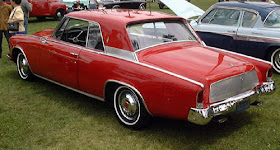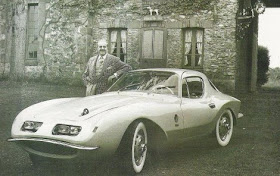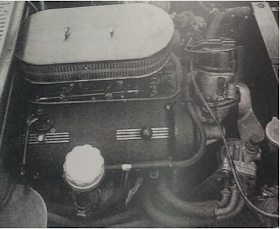By 1961, there had already been an example or two of what we'd call "retro cars" today, like the 1956 La Salle show cars from GM, designed to recall the flamboyant designs of the 1930s. Some British manufacturers were still making designs from the 1940s (the Morris Minor) or the 1930s (the Morgan) but these weren't retro cars, and there wasn't anything postmodern about them. They were just obsolete designs made with old tooling. The postmodern attitude goes beyond mere nostalgia for the long ago; it asks us to look at familiar forms and patterns with new eyes, and allows us to appreciate things which may be too new for nostalgia, but perhaps are just old enough to be out of fashion. At the Paris Auto Show in 1961, crowds were stunned by the appearance of the Kelly Corvette on the stand of renowned coach builder Vignale. But, appearances to the contrary, while the car was indeed a material product of Alfredo Vignale's workshops, all of its design, from overall concept to the tiniest obsessive detail, came from Wisconsin. In 1960, an industrial designer named Gordon Kelly, whose day job was at Brooks Stevens Associates in Milwaukee (and whose customers included Studebaker and Kaiser Willys), bought a new Corvette and designed a body which signaled the arrival of the postmodern car, nearly 30 years before Mazda gave us the Miata, and 35 years in advance of Audi's TT. The freshness and bold simplicity of the resulting design, which still startles onlookers, may owe its origin to the fact that this was not a project for a client; from the outset it was to be Gordon Kelly's personal car.
It was clear to many observers, including to this writer, then sketching cars at the back of 6th grade social studies class, that Kelly's real inspiration, his point of departure, had been the Ferrari coupes penned by Giovanni Michelotti and built by Vignale in 1951-52. And it seemed that the motivation behind this was not nostalgia, but genuine admiration for the best aspects of those Ferraris. As evidence, I'd cite the fact that by 1960, the Vignale Ferraris were mostly forgotten, tired used cars, and Kelly could have bought one for $4k to $6k, expensive but much less than he spent on this Corvette. And I'd note that in his design, Kelly doubled down on the signature features of the Vignale designs. These include the pronounced curvature of the unadorned surfaces, the sense in which the exterior skin is tightly stretched over the structure and machinery, and the emphasis on the wheels as a design element, which is aided by placement of the wheels unusually close to the edges of the car in both plan and side elevation. And of course, by selecting Vignale to build the car, Kelly insured that the ideas in his drawings and model would find a sensitive expression in metal...
The front view shows how the grille opening echoes the egg crate oval of the Ferrari; at the same time the shape is modernized by having its boundaries follow a simple section through the bodywork. Note also that at this point, the section through the forward part of the hood is a simple oval. Unlike Vignale's Ferrari 340 and 225 shown below, the fenders do not project above the hood line. At the A-pillar, Kelly's windshield more nearly fills the arc of the roof, and the side windows are a glassier interpretation of those on the Ferrari. The profile of the car on the wall underlines the purity of those curves.
Moving around to the rear, we can see that Kelly has emphasized the roundness and unity of form by erasing the boundary between the roof forms and rear fender forms. Instead of the roof and fender following stacked ovoid sections as on the blue Ferrari 212, here Kelly merges the two forms, and links the front and rear wheels with a crease which fades aft of the wheels. This detail, along with the long wheelbase / short overhang proportions, anticipates the work of Nissan's and Audi's design studios forty years later. It's as if Gordon Kelly has found a hole in the space / time continuum and calmly walked through it. Other features show a straightforward practicality; the substitution of the glassy hatch for the small trunk lid, and the tidy recesses for the trunk latch, license plate and tail lights are simple and sufficient. The 8-lug wheels express finned alloy brake drums (obsolete even in '61 but pretty). The black rubber shapes which form bumpers replaced the bright metal exhaust outlets which doubled as bumpers when Kelly first showed the car. Happy with his handiwork (and Vignale's), Gordon Kelly kept this car for the rest of his life...
When I was a 12 year-old aspiring designer who had just read Raymond Loewy's book, I ranked early 50s Vignale Ferraris with Frank Lloyd Wright's Falling Water as nearly perfect man-made things. Tiny, lightweight and simple, their design attitude seemed to say, "We don't have time for styling; we're going racing." But Gordon Kelly showed how seeming perfection could be used as a springboard for new explorations. In his obsessive pursuit of his dream, he found the benefits of the quest embodied in Loewy's dictum: never leave well enough alone.
For a video drive in the Kelly Corvette, go to:
http://www.roadandtrack.com/car-culture/classic-cars/videos/a28127/coachbuilt-corvette-is-like-driving-a-van-gogh-work-of-art/
Photo Credits:
Top: Corbin Snyder Photography / corbinsnyder.com
Note: Mr. Snyder did the photos for a forthcoming book on the Kelly Corvette entitled "Driven by a Dream."
2nd: Vignale
3rd (340 MM coupe) & 4th (225 coupe): the author
5th: coachbuild.com
6th: the author
Bottom: tabloidcar.com









































